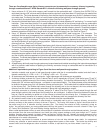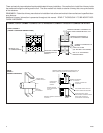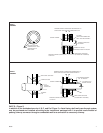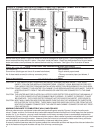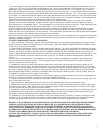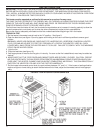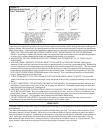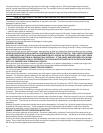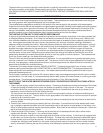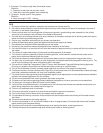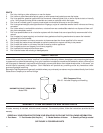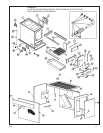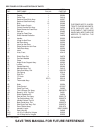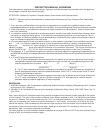
EC95 15
2. Symptom: Fire rate too high when thermostat closed:
Check for:
a. Feed door or ash door not securely closed.
b. Feed door or ash door gasket worn excessively.
3. Symptom: Smoke smell in living space:
Check for:
a. Items a through f of NO. 1 above.
FINAL CHECKLIST OF DO’S AND DON’TS
DO’S
1. Do read and follow the installation, operation and maintenance manual carefully.
2. Do install a smoke detector in an area that will give warning in the unlikely event that a fire develops in the area of
the heater or the heater malfunctions.
3. Do be sure that there is a fire extinguisher of the proper type and in good working order accessible in the unlikely
event that a fire develops near the heater of the heater malfunctions.
4. Do check with local building officials to be sure installation of the heater complies with all building codes and require
ments and obtain required building permits.
5. Do plan your installation with safety as your primary consideration.
6. do keep all flammable liquids, gases and pressurized containers away from heater.
7. Do complete the installation before attempting to use the heater.
8. Do use only the prescribed materials and parts for the installation of the heater.
9. Do install the heater in an area that will minimize the hazards of persons coming in contact with the hot surfaces of
the heater.
10. Do instruct all responsible persons in the proper and safe operation of the heater.
11. Do instruct all persons, especially children and elderly persons, of the hazards involved with the heater and im
proper and unauthorized tampering with the heater.
12. Do check the heater for proper adjustment and operation before leaving it unattended for long periods of time.
13. Do start a fire only with paper, kindling or solid composition fire starters specifically designed for starting a fire. The
use of liquid fire starters can cause an explosion within the heater.
14. Do use only a Listed High Temperature Type HT Factory-built Residential Type and Building Heating Appliance
Chimney or a properly constructed and maintained masonry chimney to vent this heater.
15. Do use 6-inch diameter chimney connector pipes made from a minimum of 24 gauge cold rolled steel.
16. Do place all ashes in a metal container with a tight fitting lid and place them on a noncombustible surface well away
from other combustible materials until they have completely cooled.
17. Do check the door latching mechanisms and gaskets regularly and replace parts or make adjustments as needed to
maintain the intended tightness of the fire chamber.
18. Do use a noncombustible floor covering beneath the heater as required.
19. Do observe all instructions regarding clearance between the appliance, chimney connector and combustibles.
20. Do store your fuel supply at least 36 inches from the heater.
21. Do build fires of moderate intensity in the appliance for the first three fires to allow the materials to adjust and cure
before being subjected to the intense heat of a large fire.
22. Do burn only seasoned wood in the heater.
23. Do be sure the heater is located in an area where combustible vapors are not present.
24. Do use a chimney for this heater that is not used by another appliance.
25. Do assemble the chimney connector so that moisture that accumulates within the chimney will flow back toward
the heater.
26. Do remove the ashes from the heater regularly.
27. Do set the thermostat on “HI” and allow the heater to burn for approximately 15 minutes after fresh wood is added
before reducing the thermostat setting.
28. Do protect your hands with noncombustible gloves when loading the heater, removing ashes, etc.
29. Do keep the heater doors closed except when refueling the heater or removing ashes.



